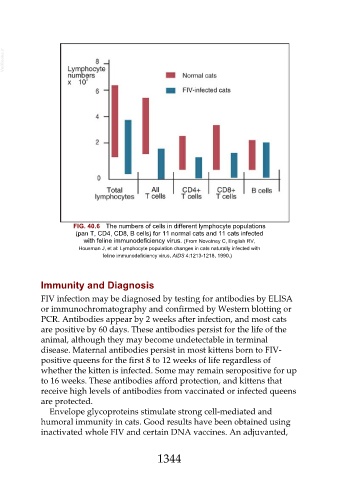Page 1344 - Veterinary Immunology, 10th Edition
P. 1344
VetBooks.ir
FIG. 40.6 The numbers of cells in different lymphocyte populations
(pan T, CD4, CD8, B cells) for 11 normal cats and 11 cats infected
with feline immunodeficiency virus. (From Novotney C, English RV,
Housman J, et al: Lymphocyte population changes in cats naturally infected with
feline immunodeficiency virus, AIDS 4:1213-1218, 1990.)
Immunity and Diagnosis
FIV infection may be diagnosed by testing for antibodies by ELISA
or immunochromatography and confirmed by Western blotting or
PCR. Antibodies appear by 2 weeks after infection, and most cats
are positive by 60 days. These antibodies persist for the life of the
animal, although they may become undetectable in terminal
disease. Maternal antibodies persist in most kittens born to FIV-
positive queens for the first 8 to 12 weeks of life regardless of
whether the kitten is infected. Some may remain seropositive for up
to 16 weeks. These antibodies afford protection, and kittens that
receive high levels of antibodies from vaccinated or infected queens
are protected.
Envelope glycoproteins stimulate strong cell-mediated and
humoral immunity in cats. Good results have been obtained using
inactivated whole FIV and certain DNA vaccines. An adjuvanted,
1344

